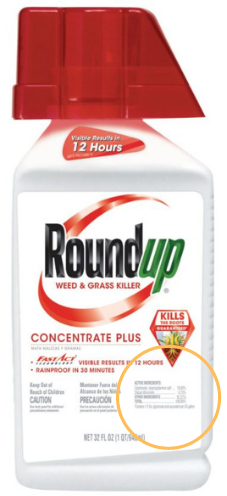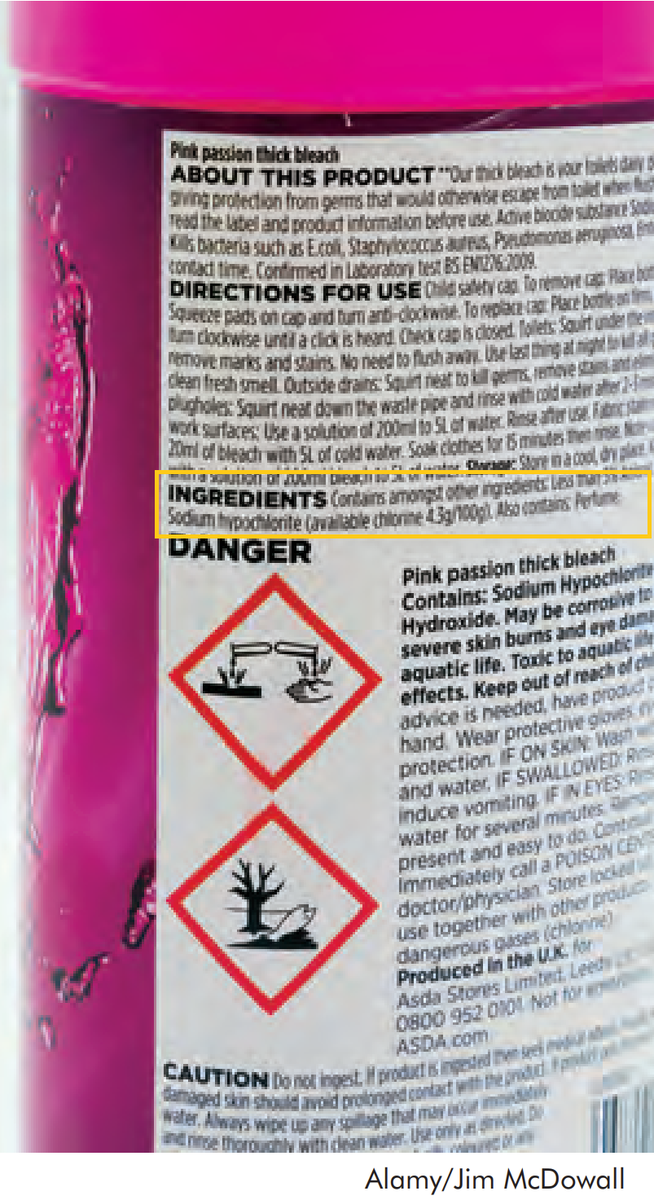Gateway on Pesticide Hazards and Safe Pest Management
How To Find Ingredients in Pesticide Products
Beyond Pesticides offers resources below to evaluate the health and ecological effects of specific chemical exposure from ACTIVE INGREDIENTS in pesticide products, as well as regulatory information and supporting scientific documents. Because various pesticide products can contain more than one active ingredient, it is important to READ the LABEL to determine chemical components.
With 192 different active ingredients and counting, it is essential to establish the connection between the use of these chemicals and their respective hazards.
View the step-by-step guide on how to search for the active ingredient(s) in pesticide products below:
- Go to U.S. EPA's Pesticide Product and Label System and enter the product name. The generic product name may vary.
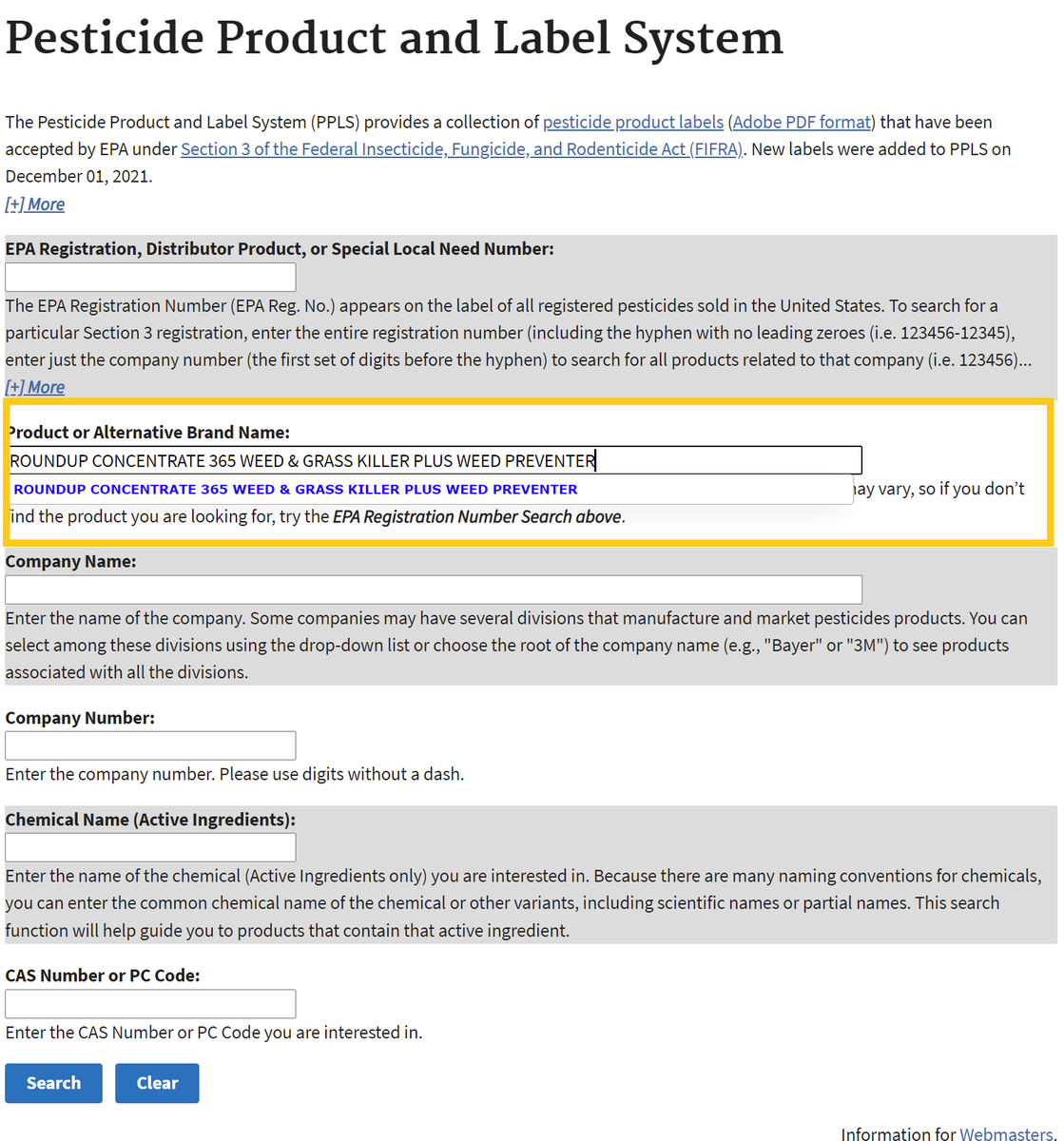
- After searching, click on the chemical ingredients tab or the link for the most recent label to find Active Ingredients.
Chemical List Label List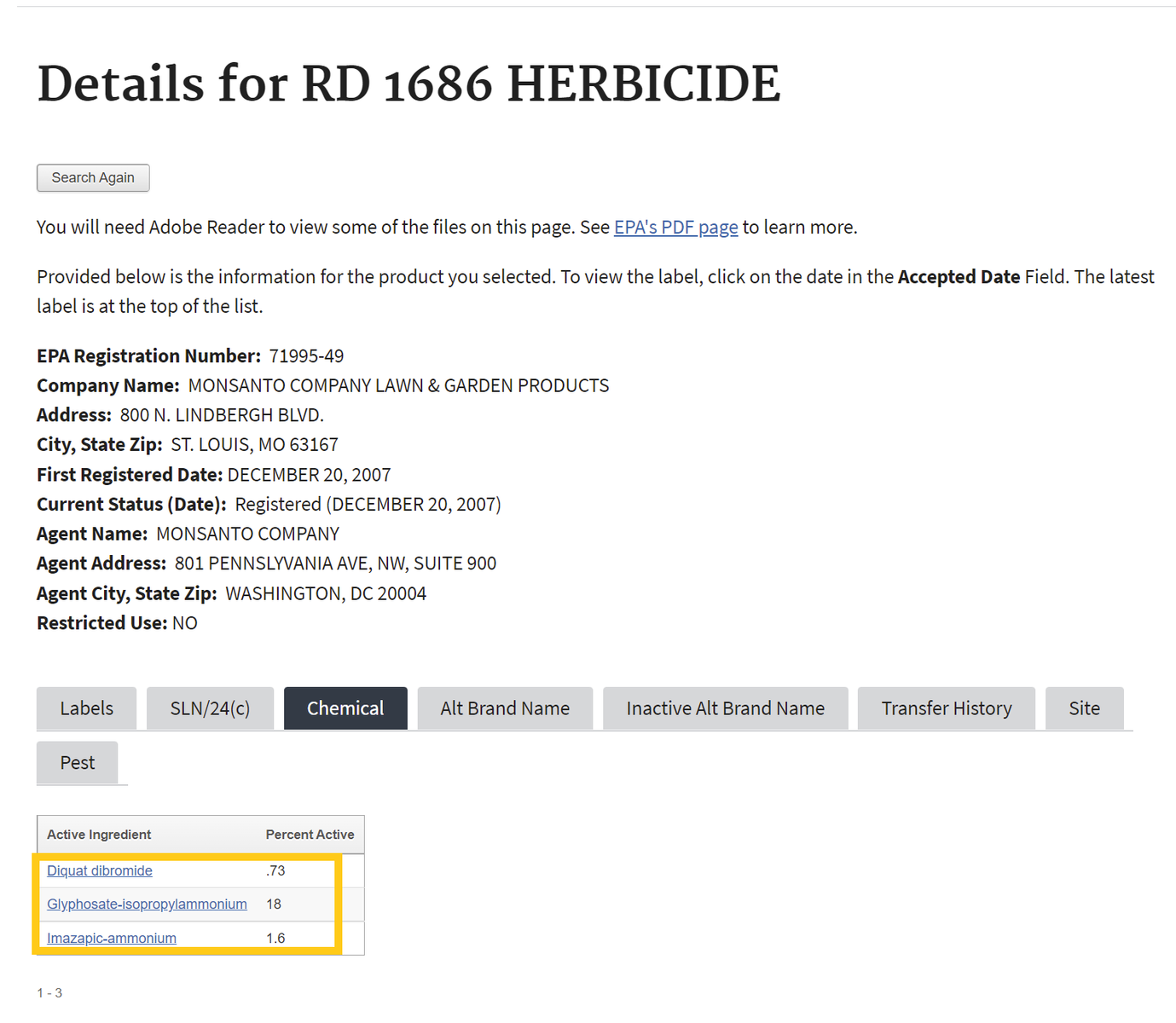
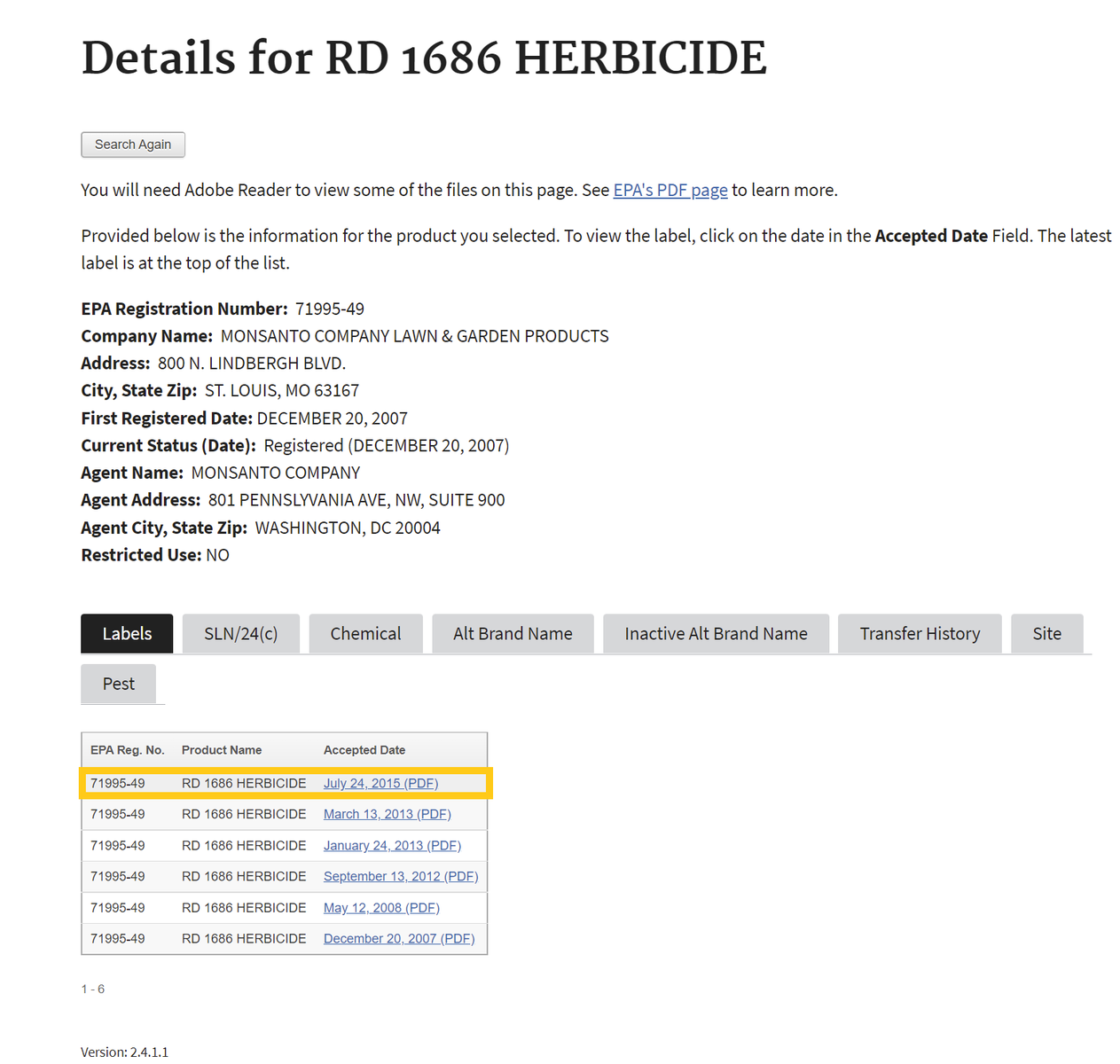
If one selects the chemical ingredients tab, skip to Step 4 . If not, proceed to step number 3 - To find the active ingredient(s) on the label, search for the page in the document containing the date of registration. Usually, the active ingredients section occurs within the first few pages of the label document.
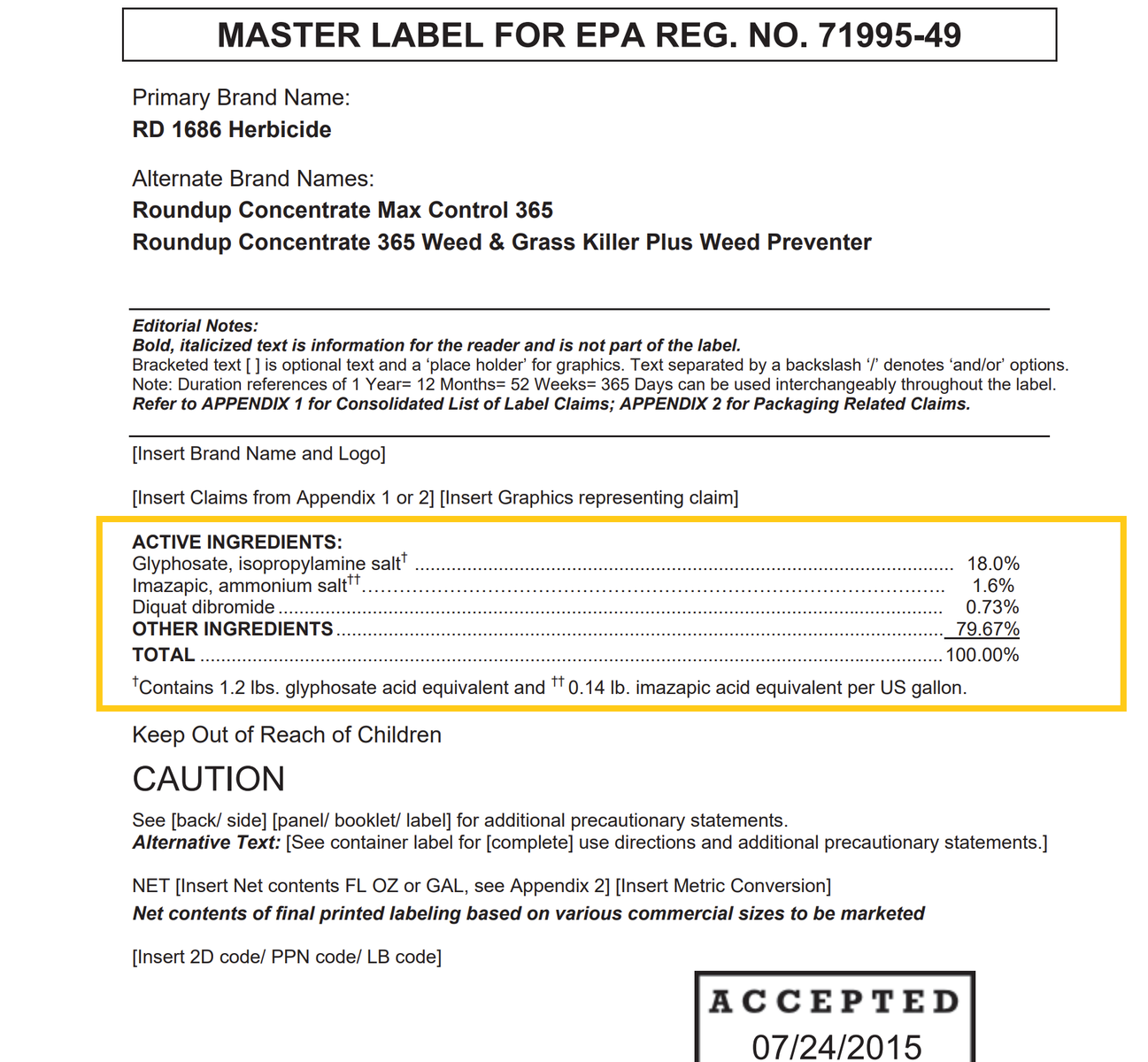
- Return to the Beyond Pesticides Gateway and search for the active ingredient name in the yellow box to the right or from the list below.
Atrazine
General Information
- Fact Sheet: Atrazine.pdf
- Product Names:
- Chemical Class: Triazine herbicide
- Uses: To control broadleaf and grassy weeds in corn, sorghum, and sugarcane, wheat, guava, macadamia nuts, and range grasses and for several nonagricultural use sites such as ornamentals, Christmas trees, sod and residential lawns and golf courses (in the Southeast)
- Alternatives: Organic agriculture, Organic Lawn care
- Beyond Pesticides rating: Toxic
Health and Environmental Effects
- Cancer: Yes (11)
- Endocrine Disruption: Known (5)
- Reproductive Effects: Yes (7)
- Neurotoxicity: Yes (4)
- Kidney/Liver Damage: Yes (4)
- Sensitizer/ Irritant: Yes (4)
- Birth/Developmental: Yes (7)
- Detected in Groundwater: Yes (4)
- Potential Leacher: Yes (4)
- Toxic to Birds: Not documented
- Toxic to Fish/Aquatic Organisms: Yes (4)
- Toxic to Bees: Not documented
Residential Uses as Found in the ManageSafe™ Database
Additional Information
- Regulatory Status:
- EPA's Atrazine Background and Updates
- BP Comments April 2025
- BP Comments (2022, 2020, 2016)
- Atrazine Monitoring Program Data and Results
- EPA Registration Review (2016)
- Draft Ecological Assessments for Triazines (2016)
- Beyond Pesticides' Draft Ecological Risk Assesment comments (10/2016)
- Atrazine EDSP Tier1 Screening Results (2015)
- Triazine Cumulative Risk Assessment (2006)
- EPA Reregistration Eligibility Decision (RED) signed (4/2006)
- Supporting information:
- Fighting Attacks on Inconvenient Science—and Scientists (Inside Climate News)
- Daily News Blog entries (Beyond Pesticides)
- Asthma, Children and Pesticides (Beyond Pesticides)
- NCAP Atrazine Fact Sheet (Northwest Coalition for Alternatives to Pesticides)
- Children & Lawn Chemicals Don't Mix (Beyond Pesticides)
- The Safer Choice (Beyond Pesticides)
- PAN Pesticides Database: Atrazine (Pesticide Action Network)
- Studies:
- The Atrazine Saga and its Importance to the Future of Toxicology, Science, and Environmental and Human Health. Rohr, J.R., 2021. Environmental Toxicology and Chemistry, 40(6), pp.1544-1558.
- Trends in pesticide concentrations and use for major rivers of the United States. Ryberg, K.R and Gilliom, R.J. 2015. Science of the Total Environment 538: 431–444.
- Demasculinization and feminization of male gonads by atrazine: Consistent effects across vertebrate classes. Hayes, T., et al. 2011. J. Steroid Biochem and Molecular Bio. 127(1-2):64-73.
- Still Poisoning the Well: Atrazine Continues to Contaminate Surface Water and Drinking Water in the United States. Wu. M, Quirindongo, M, et al. 2010. Natural Resources Defense Council. Washington DC
- Pesticide Mixtures, Endocrine Disruption, and Amphibian Declines: Are We Underestimating the Impact? Hayes et. al 2006. Environmental Health Perspectives.
- Debating How Much Weed Killer Is Safe in Your Water Glass. The New York Times, 2009.
- Agrichemicals in surface water and birth defects in the United States. Winchester, et al. April 2009.
- A longitudinal study of atrazine and 2,4-D exposure and oxidative stress markers among iowa corn farmers.. Lerro CC, Beane Freeman LE, Portengen L, Kang D, et al. 2017. Environ Mol Mutagen. 58(1):30-38.
- Agricultural risk factors for t(14;18) subtypes of non-Hodgkin's lymphoma.. Schroeder, J., et al. 2001. Epidemiology 12(6):701-709
- Association between Exposure to Endocrine Disruptors in Drinking Water and Preterm Birth, Taking Neighborhood Deprivation into Account: A Historic Cohort Study.. Albouy-Llaty M, Limousi F, Carles C, Dupuis A, et al. 2016. Int J Environ Res Public Health.13(8).
- Associations between stomach cancer incidence and drinking water contamination with atrazine and nitrate in Ontario (Canada) agroecosystems, 1987-1991. Van Leeuwen, J.A., et al. 1999. International Journal of Epidemiology 28:836-840.
- US EPA's regulatory pesticide evaluations need clearer guidelines for considering mammary gland tumors and other mammary gland effects. Cardona, B. and Rudel, R.A., 2020. Molecular and Cellular Endocrinology, p.110927.
- Atrazine in public water supplies and risk of ovarian cancer among postmenopausal women in the Iowa Women's Health Study.. Inoue-Choi M, Weyer PJ, Jones RR, Booth BJ, et al. 2016. Occup Environ Med. 73(9):582-7
- Atrazine promotes RM1 prostate cancer cell proliferation by activating STAT3 signaling.. Hu K, Tian Y, Du Y, Huang L, Chen J, et al. 2016. Int J Oncol. 48(5):2166-74
- Cancer incidence among triazine herbicide manufacturing workers. MacLennan, P.A., et al. 2002. J Occup Environ Med 44(11):1048-1058.
- Characterization of endocrine-disrupting chemicals based on hormonal balance disruption in male and female adult rats.. Quignot N, Arnaud M, Robidel F, Lecomte A, et al. 2012. Reprod Toxicol. 33(3):339-52.
- Chemical predictors of wheeze among farmer pesticide applicators in the Agricultural Health Study.. Hoppin, JA, DM Umbach, SJ London, et al. 2002. M J Respir Crit Care Med 165: 683-689
- Combined effects of repeated administration of Bretmont Wipeout (glyphosate) and Ultrazin (atrazine) on testosterone, oxidative stress and sperm quality of Wistar rats.. Abarikwu SO, Akiri OF, et al. 2015. Toxicol Mech Methods.25(1):70-80.
- Effects of prenatal exposure to a low dose atrazine metabolite mixture on pubertal timing and prostate development of male Long-Evans rats. Stanko JP, et al. 2010. Reprod Toxicol. Epub ahead of print. DOI:10.1016/j.reprotox.2010.07.006
- Pre-differentiation exposure to low-dose of atrazine results in persistent phenotypic changes in human neuronal cell lines. Xie, J., Lin, L., Sánchez, O.F., Bryan, C., Freeman, J.L. and Yuan, C., 2021. Environmental Pollution, 271, p.116379.
- In utero exposure to atrazine analytes and early menarche in the Avon Longitudinal Study of Parents and Children Cohort.. Namulanda G, Taylor E, Maisonet M, Boyd Barr D, et al. 2017. Environ Res. 156:420-425.
- Atrazine Inhalation Worsen Pulmonary Fibrosis Regulating the Nuclear Factor-Erythroid 2-Related Factor (Nrf2) Pathways Inducing Brain Comorbidities. D'Amico, R., Monaco, F., Fusco, R., Siracusa, R., Impellizzeri, D., Peritore, A.F., Crupi, R., Gugliandolo, E., Cuzzocrea, S., Di Paola, R. and Genovese, T. Cell Physiol Biochem, 55, pp.704-725.
- Atrazine Inhalation Worsen Pulmonary Fibrosis Regulating the Nuclear Factor Erythroid 2-Related Factor (Nrf2) Pathways Inducing Brain Comorbidities. D’Amico, R., Monaco, F., Fusco, R., Siracusa, R., Impellizzeri, D., Peritore, A.F., Crupi, R., Gugliandolo, E., Cuzzocrea, S., Di Paola, R. and Genovese, T. Cell. Physiol. Biochem, 55, pp.704-725.
- Anthropogenic Contaminants and Histopathological Findings in Stranded Cetaceans in the Southeastern United States, 2012–2018. Page-Karjian, A., Lo, C.F., Ritchie, B., Harms, C.A., Rotstein, D.S., Han, S., Hassan, S.M., Lehner, A.F., Buchweitz, J.P., Thayer, V.G. and Sullivan, J.M., 2020. Frontiers in Marine Science, 7, p.630.
- Long-term maternal exposure to atrazine in the drinking water reduces penis length in the tammar wallaby Macropus eugenii. Cook, L.E., Chen, Y., Renfree, M.B. and Pask, A.J., 2020. Reproduction, Fertility and Development, 32(13), pp.1168-1168.
- Atrazine promotes breast cancer development by suppressing immune function and upregulating MMP expression. Wang, M., Chen, J., Zhao, S., Zheng, J., He, K., Liu, W., Zhao, W., Li, J., Wang, K., Wang, Y. and Liu, J., 2023. Ecotoxicology and Environmental Safety, 253, p.114691.
- Mammary Gland Development as a Sensitive End Point after Acute Prenatal Exposure to an Atrazine Metabolite Mixture in Female Long-Evans Rats. Enoch R.R., et al. 2007. Environmental Health Perspectives, 115(4).
- Urinary Biomarkers of Prenatal Atrazine Exposure and Adverse Birth Outcomes in the PELAGIE Birth Cohort. Chevrier C, Limon G, Monfort C, Rouget F, Garlantézec R, Petit C, et al. 2011. Environ Health Perspect. doi:10.1289/ehp.1002775
- Impact of Chronic Multi-Generational Exposure to an Environmentally Relevant Atrazine Concentration on Testicular Development and Function in Mice. Kolaitis, N.D., Finger, B.J., Merriner, D.J., Nguyen, J., Houston, B.J., O’Bryan, M.K., Stringer, J.M., Zerafa, N., Nguyen, N., Hutt, K.J. and Tarulli, G.A., 2023. Cells, 12(4), p.648.
- Haematological and biochemical toxicity in freshwater fish Clarias gariepinus and Oreochromis niloticus following pulse exposure to atrazine, mancozeb, chlorpyrifos, lambda-cyhalothrin, and their combination. Kanu, K.C., Okoboshi, A.C. and Otitoloju, A.A., 2023. Comparative Biochemistry and Physiology Part C: Toxicology & Pharmacology, 270, p.109643.
- Atrazine: cytotoxicity, oxidative stress, apoptosis, testicular effects and chemopreventive Interventions.. Abarikwu, S.O., Ezim, O.E., Ikeji, C.N. and Farombi, E.O., Atrazine: Cytotoxicity, Frontiers in Toxicology, 5, p.1246708.
- Assessing the ecological impact of pesticides/herbicides on algal communities: A comprehensive review. Narayanan, N. et al. (2024) Assessing the ecological impact of pesticides/herbicides on algal communities: A comprehensive review, Aquatic Toxicology. Available at: https://www.sciencedirect.com/science/article/abs/pii/S0166445X24000225?via%3Dihub.
- Maternal Residential Atrazine Exposure and Risk for Choanal Atresia and Stenosis in Offspring. Agopian, A.J. et al. (2014) Maternal residential atrazine exposure and risk for choanal atresia and stenosis in offspring, The Journal of Pediatrics. Available at: https://www.ncbi.nlm.nih.gov/pmc/articles/PMC4105141/.
- Atrazine induces penis abnormalities including hypospadias in mice. Govers, L. et al. (2020) Atrazine induces penis abnormalities including hypospadias in mice, Journal of developmental origins of health and disease. Available at: https://pubmed.ncbi.nlm.nih.gov/31475654/.
- Atrazine induces complete feminization and chemical castration in male African clawed frogs (Xenopus laevis). Hayes, T. et al. (2010) Atrazine induces complete feminization and chemical castration in male African clawed frogs (xenopus laevis), Proceedings of the National Academy of Sciences. Available at: https://www.pnas.org/doi/10.1073/pnas.0909519107.
- The Atrazine Saga and its Importance to the Future of Toxicology, Science, and Environmental and Human Health. Rohr, J. (2021) The atrazine saga and its importance to the future of toxicology, Science, and environmental and human health, Environmental toxicology and chemistry. Available at: https://pubmed.ncbi.nlm.nih.gov/33999476/.
- An embryonic atrazine exposure results in reproductive dysfunction in adult zebrafish and morphological alterations in their offspring. Wirbisky, S.E. et al. (2016) An embryonic atrazine exposure results in reproductive dysfunction in adult zebrafish and morphological alterations in their offspring, Scientific Reports. Available at: https://www.nature.com/articles/srep21337.
- Estimating the aquatic risk from exposure to up to twenty-two pesticide active ingredients in waterways discharging to the Great Barrier Reef. Warne, M. et al. (2023) Estimating the aquatic risk from exposure to up to twenty-two pesticide active ingredients in waterways discharging to the Great Barrier Reef, Science of The Total Environment. Available at: https://www.sciencedirect.com/science/article/pii/S0048969723032552.
- Thyroid under Attack: The Adverse Impact of Plasticizers, Pesticides, and PFASs on Thyroid Function. Rodrigues, V.G. et al. (2024) Thyroid under Attack: The Adverse Impact of Plasticizers, Pesticides, and PFASs on Thyroid Function, Endocrines. Available at: https://www.mdpi.com/2673-396X/5/3/32.
- .
- Brief research report pesticide occupational exposure leads to significant inflammatory changes in normal mammary breast tissue . da Silva, R.G. et al. (2023) ‘Brief research report pesticide occupational exposure leads to significant inflammatory changes in normal mammary breast tissue’, Frontiers in Public Health, 11. doi:10.3389/fpubh.2023.1229422.
- Predicting the relationship between pesticide genotoxicity and breast cancer risk in South Indian women in in vitro and in vivo experiments . Sasikala, S. et al. (2023) ‘Predicting the relationship between pesticide genotoxicity and breast cancer risk in south Indian women in in vitro and in vivo experiments’, Scientific Reports, 13(1). doi:10.1038/s41598-023-35552-3.
- Pesticide-Induced Inflammation at a Glance. Lopes-Ferreira, M. et al. (2023) ‘Pesticide-induced inflammation at a glance’, Toxics, 11(11), p. 896. doi:10.3390/toxics11110896.
- Effects of microplastics on the environmental behaviors of the herbicide atrazine in soil: Dissipation, adsorption, and bioconcentration. Guo, J., Du, Y., Yang, L., Luo, Y., Zhong, G., Zhao, H. M., & Liu, J. (2024). Effects of microplastics on the environmental behaviors of the herbicide atrazine in soil: Dissipation, adsorption, and bioconcentration. Journal of hazardous materials, 465, 133085. https://doi.org/10.1016/j.jhazmat.2023.133085
- The influence of polyethylene microplastics on pesticide residue and degradation in the aquatic environment. Wang, F., Gao, J., Zhai, W., Liu, D., Zhou, Z., & Wang, P. (2020). The influence of polyethylene microplastics on pesticide residue and degradation in the aquatic environment. Journal of hazardous materials, 394, 122517. https://doi.org/10.1016/j.jhazmat.2020.122517
- Geospatial Distribution of Age-Adjusted Incidence of the Three Major Types of Pediatric Cancers and Waterborne Agrichemicals in Nebraska. Ouattara, B. S., Puvvula, J., Abadi, A., Munde, S., Kolok, A. S., Bartelt-Hunt, S., Bell, J. E., Wichman, C. S., & Rogan, E. (2022). Geospatial Distribution of Age-Adjusted Incidence of the Three Major Types of Pediatric Cancers and Waterborne Agrichemicals in Nebraska. GeoHealth, 6(2), e2021GH000419. https://doi.org/10.1029/2021GH000419
- A cocktail of contaminants: how mixtures of pesticides at low concentrations affect aquatic communities. Relyea R. A. (2009). A cocktail of contaminants: how mixtures of pesticides at low concentrations affect aquatic communities. Oecologia, 159(2), 363–376. https://doi.org/10.1007/s00442-008-1213-9
- Toxicity of atrazine, glyphosate, and quinclorac in bullfrog tadpoles exposed to concentrations below legal limits. Dornelles, M.F., Oliveira, G.T. Toxicity of atrazine, glyphosate, and quinclorac in bullfrog tadpoles exposed to concentrations below legal limits. Environ Sci Pollut Res 23, 1610–1620 (2016). https://doi.org/10.1007/s11356-015-5388-4
- Adverse Effects of Pesticides on the Ovary: Evidence from Epidemiological and Toxicological Studies. Wang, L., Ma, X. and Liu, J. (2025) Adverse Effects of Pesticides on the Ovary: Evidence from Epidemiological and Toxicological Studies, Environment & Health. Available at: https://pubs.acs.org/doi/full/10.1021/envhealth.4c00243.
- Differential effects of herbicides atrazine and fenoxaprop-ethyl, and insecticides diazinon and malathion, on viability and maturation of porcine oocytes in vitro. Casas, E., Bonilla, E., Ducolomb, Y., & Betancourt, M. (2010). Differential effects of herbicides atrazine and fenoxaprop-ethyl, and insecticides diazinon and malathion, on viability and maturation of porcine oocytes in vitro. Toxicology in vitro : an international journal published in association with BIBRA, 24(1), 224–230. https://doi.org/10.1016/j.tiv.2009.09.004
- Menstrual cycle characteristics and reproductive hormone levels in women exposed to atrazine in drinking water. Cragin, L. A., Kesner, J. S., Bachand, A. M., Barr, D. B., Meadows, J. W., Krieg, E. F., & Reif, J. S. (2011). Menstrual cycle characteristics and reproductive hormone levels in women exposed to atrazine in drinking water. Environmental research, 111(8), 1293–1301. https://doi.org/10.1016/j.envres.2011.09.009
- Therapeutic Effects of Ascorbic Acid on Hormonal and Histological Alteration Produced in The Reproductive System of Albino Rats Intoxicated by Herbicide Atrazine. Youssef, Abdel & Salem, Mahmoud & Saber, Samy & Nabeeh, Ahmed. (2021). Therapeutic Effects of Ascorbic Acid on Hormonal and Histological Alteration Produced in The Reproductive System of Albino Rats Intoxicated by Herbicide Atrazine. Egyptian Academic Journal of Biological Sciences. 13. 1-16.
- Collaborative work on evaluation of ovarian toxicity: Two- or four-week repeated-dose studies and fertility study of atrazine in female rats. Hiroshi Shibayama, Takashi Kotera, Yasuhiko Shinoda, Tomohiko Hanada, Tsutomu Kajihara, Makoto Ueda, Hideyuki Tamura, Seitarou Ishibashi, Yasuhiro Yamashita, Seishi Ochi, Collaborative work on evaluation of ovarian toxicity 14) Two- or four-week repeated-dose studies and fertility study of atrazine in female rats, The Journal of Toxicological Sciences, 2009, Volume 34, Issue Special, Pages SP147-SP155, Released on J-STAGE February 20, 2009, Online ISSN 1880-3989, Print ISSN 0388-1350, https://doi.org/10.2131/jts.34.S147, https://www.jstage.jst.go.jp/article/jts/34/Special/34_Special_SP147/_article/-char/en
- Effect of Nrf2 on rat ovarian tissues against atrazine-induced anti-oxidative response. Zhao, F., Li, K., Zhao, L., Liu, J., Suo, Q., Zhao, J., Wang, H., & Zhao, S. (2014). Effect of Nrf2 on rat ovarian tissues against atrazine-induced anti-oxidative response. International journal of clinical and experimental pathology, 7(6), 2780–2789.
- Widespread Pesticide Distribution in the European Atmosphere Questions their Degradability in Air. Mayer, L., Degrendele, C., Šenk, P., Kohoutek, J., Přibylová, P., Kukučka, P., Melymuk, L., Durand, A., Ravier, S., Alastuey, A., Baker, A. R., Baltensperger, U., Baumann-Stanzer, K., Biermann, T., Bohlin-Nizzetto, P., Ceburnis, D., Conil, S., Couret, C., Degórska, A., Diapouli, E., … Lammel, G. (2024). Widespread Pesticide Distribution in the European Atmosphere Questions their Degradability in Air. Environmental science & technology, 58(7), 3342–3352. Advance online publication. https://doi.org/10.1021/acs.est.3c08488
- Pesticide contamination in indoor home dust: A pilot study of non-occupational exposure in Argentina. Aparicio, Virginia & Kaseker, Jessica & Scheepers, Paul & Alaoui, Abdallah & Figueiredo, Daniel & Mol, H. & Silva, Vera & Harkes, Paula & dos Santos, Danilo & Geissen, Violette & Costa, José. (2025). Pesticide Contamination in Indoor Home Dust: A Pilot Study of Non-Occupational Exposure in Argentina. Environmental Pollution. 373. 126208. 10.1016/j.envpol.2025.126208.
- Pesticide exposure induces risks of gestational anemia by maternal gut microbiota: A prospective cohort study. Dong, C., Yu, S., Deng, S., Xia, Z., Rigoberto, F. C., Sultan, M., Xu, X., Jin, B., Guan, Q., Sun, Z., & Xia, Y. (2025). Pesticide exposure induces risks of gestational anemia by maternal gut microbiota: A prospective cohort study. Journal of hazardous materials, 494, 138465. Advance online publication. https://doi.org/10.1016/j.jhazmat.2025.138465
- Recent trends in pesticides in crops: A critical review of the duality of risks-benefits and the Brazilian legislation issue. Souza, M. C. O., Cruz, J. C., Cesila, C. A., Gonzalez, N., Rocha, B. A., Adeyemi, J. A., Nadal, M., Domingo, J. L., & Barbosa, F. (2023). Recent trends in pesticides in crops: A critical review of the duality of risks-benefits and the Brazilian legislation issue. Environmental research, 228, 115811. https://doi.org/10.1016/j.envres.2023.115811
- Pesticides residues in pet food: A market-based study on prevalence and toxicological implications. Macías-Montes, A. et al. (2025) Pesticides residues in pet food: A market-based study on prevalence and toxicological implications, Environmental Pollution. Available at: https://www.sciencedirect.com/science/article/pii/S0269749125007729.
- Mechanisms of Neurotoxicity Associated with Exposure to the Herbicide Atrazine. Stradtman, S. C., & Freeman, J. L. (2021). Mechanisms of Neurotoxicity Associated with Exposure to the Herbicide Atrazine. Toxics, 9(9), 207. https://doi.org/10.3390/toxics9090207
- Inputs, source apportionment, and transboundary transport of pesticides and other polar organic contaminants along the lower Red River, Manitoba, Canada. Challis, J. K., Cuscito, L. D., Joudan, S., Luong, K. H., Knapp, C. W., Hanson, M. L., & Wong, C. S. (2018). Inputs, source apportionment, and transboundary transport of pesticides and other polar organic contaminants along the lower Red River, Manitoba, Canada. The Science of the total environment, 635, 803–816. https://doi.org/10.1016/j.scitotenv.2018.04.128
- A regional assessment of chemicals of concern in surface waters of four Midwestern United States national parks. Elliott, S. M., & VanderMeulen, D. D. (2017). A regional assessment of chemicals of concern in surface waters of four Midwestern United States national parks. The Science of the total environment, 579, 1726–1735. https://doi.org/10.1016/j.scitotenv.2016.11.114
- Occurrence of Current-Use Pesticides in Paired Indoor Dust, Drinking Water, and Urine Samples from the United States: Risk Prioritization and Health Implications. Xie, Y., Li, J., Salamova, A., & Zheng, G. (2025). Occurrence of Current-Use Pesticides in Paired Indoor Dust, Drinking Water, and Urine Samples from the United States: Risk Prioritization and Health Implications. Environmental science & technology, 59(25), 12507–12519. https://doi.org/10.1021/acs.est.5c00961








.png)
